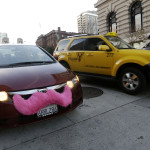Thousands of new full-time workers would spring into existence if Uber is forced to stop treating some of its drivers like contract workers, and the benefits that come with that employee status may entice part-time rideshare drivers to beef up their hours of operation.
A recent study from consumer finance site NerdWallet shows Uber drivers in six major U.S. cities would receive paid holidays and healthcare benefits worth an average of $5,500 a year, plus thousands of dollars more in mileage reimbursement, if the San Francisco-based firm provided them with the same benefits as its full-time employees.
The catalyst for the study is a California Labor Commissioner’s ruling in June that Uber driver Barbara Berwick was an employee of the company and not a contractor. The ruling ordered Uber to reimburse Berwick $3,878 for mileage and tolls plus $274 in interest.
In a similar matter, the Florida Department of Economic Opportunity decided in May that former Uber driver Darrin McGillis had been an employee, which entitled him to unemployment benefits.
Both decisions apply only to the individuals involved, and do not set laws or regulations that Uber must follow with the rest of its employees in those states. Uber is appealing those decisions.
 In its appeal, Uber noted that in California, a previous ruling by the same commission concluded in 2012 that a driver performed services as an independent contractor, and not as a bona fide employee.
In its appeal, Uber noted that in California, a previous ruling by the same commission concluded in 2012 that a driver performed services as an independent contractor, and not as a bona fide employee.
In a case that could be turned into a class-action suit and cover all of Uber’s drivers, three drivers took Uber to a federal court in San Francisco, contending they are employees and entitled to reimbursement for expenses, including gas and vehicle maintenance. The case in U.S. District Court, Northern District of California is Douglas O’Connor et al vs. Uber Technologies Inc.
Uber provided a statement on that suit:
“Eighty seven per cent of drivers say the main reason to use Uber is because they love being their own boss. As employees, drivers would drive set shifts, earn a fixed hourly wage, and lose the ability to drive using other ridesharing apps as well as the personal flexibility they most value. The reality is that drivers use Uber on their own terms: they control their use of the app. It’s why there’s no typical driver–the key question in this case. And why no three people can ever represent the interests of so many different drivers.”
Aside from the possibility of a class-action suit, should the existing labor decisions be upheld, some believe more rideshare drivers could be motivated to seek status as full-time employees.
Just how many employees this affects isn’t clear, but if all Uber drivers were considered full-time employees the firm would rank among the top 50 U.S. employers by size – somewhere above Boeing Co. and Starbucks, and below Safeway and Bank of America.
Uber in January reported that nearly 14 percent of its 160,000-and-counting U.S. drivers worked at least 35 hours a week. The firm also reported drivers earned $17.56 on average.
There are no specific figures for the numbers of Uber drivers in each state, but Harry Campbell, who blogs for Forbes on the topic of ridesharing, believes California has a larger percentage of rideshare drivers who are full-time.
His reasoning is that the state is where the ridesharing craze first exploded, and a significant portion of California is thin on mass transit and heavily automobile reliant.
Campbell, who often polls rideshare drivers on his website, TheRideShareGuy.com, estimates that roughly 30 percent of Uber drivers spend 40 hours or more per week scouring the streets for rides and taking passengers to and fro.
“I do think there’s a lot of drivers that this with would affect,” Campbell said.
Asked to put a number on the total number of full-time Uber drivers, he postulated that as many as 15,000 could be considered full-time employees.
The NerdWallet study outlined the benefits costs for those employees in paid holidays, health insurance, mileage reimbursement and auto insurance.
Based on Uber’s stated average hourly wage for full-time drivers, the change in employment status adds up to $1,264.32 for nine paid holidays each year. Health insurance costs vary by area, but in Los Angeles it’s $2,859 per year and New York it’s $3,585 per year, according to NerdWallet.
To calculate estimated mileage reimbursement the study uses Berwick’s driving totals, which if extrapolated to full year would add up to 38,808 miles. An employee driving those miles would get $22,315 in reimbursement.
Auto insurance rates also vary by locale, but in Los Angeles it’s $1,175.61 and in New York it’s $1,614.71, the study shows.
Jeffrey Chu, the author of the study, said he stuck to a barebones comparison and left out other cost factors, such as workers’ compensation insurance, which would depend on Uber’s business model going forward if some of its drivers were considered full-time.
He thinks the figures in the study are enough to entice some drivers to consider upping their rideshare driving each week.
“If Uber provided full-time benefits, that would motivate more drivers to become full-time,” Chu said.
Uber has argued that many rideshare drivers don’t want to be full-time, because they drive to augment their existing income and they don’t want to give up their flexibility and independence.
According to a poll by Uber of its own drivers: 85 of respondents cited more flexibility in their schedule and balance their work with life and family as a major reason to work with Uber; 50 percent of U.S. Uber driver-partners drive on average fewer than 10 hours per week; and 65 percent of driver-partners changed the number of hours they worked by more than 25 percent from one week to the next.
Campbell believes some compromise in the employee vs. contractor issue could be found that benefits both full-time drivers and Uber
“I think there’s a lot of room for compromise or middle-grounds where Uber could provide more benefits,” he said.
He believes a compromise in which certain benefits were offered to full-time drivers would enable Uber to also benefit by allowing it more control over those drivers, such as enabling the firm to ensure that fewer are drivers are bunched together to offer rides from the 9 a.m.-to-5 p.m. midweek slow time and that more drivers were available during the primetime operating hours.
“I think that Uber has the mindset that the situation is all or nothing,” Campbell said. “I think that’s pretty misleading.”
Linda T. Pierce, an attorney and area executive vice president with global brokerage Arthur J. Gallagher in Glendale, Calif., views workers’ comp as a major consideration for Uber going forward if the Berwick decision is upheld and other drivers seek the same status.
Pierce believes workers’ comp judges overseeing disputes involving Uber drivers could use the Labor Commissioner’s ruling as guidance.
“It would likely be a test a workers’ comp judge would use,” Pierce said. “I think that’s a real possibility.”
The Berwick case fits an existing mold in which for years people have been classified as an independent contractor and have brought a case to get worker’s comp benefits, unemployment benefits or disability benefits.
“There’s all sorts of different agencies that are pitfalls for California entities that use independent contractors,” Pierce said.
As soon as enough Uber drivers are hurt on the job and they begin seeking workers’ comp benefits, that’s when trouble may arise between Uber and its insurer, she added.
“If they get claims put in, they run the risk of being audited by their carrier and being assessed a huge premium,” Pierce said, adding that there’s also danger the carrier would just rescind the policy.
Bob King, an attorney and founder of Legally Nanny, a California law firm that specializes in household employment, sees the decision in the Berwick case as far-reaching and “very dangerous for Uber.”
The Labor Commissioner made the findings in the Berwick case based on level of control Uber exercises over its drivers. So unless the decision is overruled, there will be plenty of savvy plaintiffs’ lawyers armed with this decision as an argument who will go out and find other Uber drivers to make the same claim, King said.
“Basically what the Labor Commissioner has done is say ‘Here’s what you have to say in your complaint to prevail,'” he said. “They’ve given employees a roadmap against Uber.”
King typically represents firms that provide nannies, elder caregivers and other similar services that often send people out to homes, but those operations sometimes misclassify their employees as independent contractors, he said.
He believes the Labor Commissioner’s ruling can be used as a standard other in other industries outside of ridesharing to show that caregivers are employees and not contractors.
“This ruling is actually a big deal for my industry as well,” King said. “This ruling puts another nail the coffin to confirm that workers are in fact employees. What this Labor Commissioner has done is provide this roadmap for employees to say the right thing in the hearing to win.”
He added, “It’s not binding precedent, but it is persuasive.”
Bryance Metheny, a partner and chair of the labor and employment practice group at Burr & Forman Burr & Forman in Birmingham, Ala., also believes such rulings aren’t going to be limited to one industry.
“The future is going to reveal it’s not going to be limited to ridesharing,” Metheny said.
Overtime pay could increasingly be another consideration Uber and others who operate with independent contractors will have to deal with if new rules proposed by the U.S. Department of Labor are enacted, he said.
The Department of Labor recently proposed updates to the Fair Labor Standards Act that would extend overtime pay to an estimated 4.6 million workers who are currently exempt from under current regulations.
These rules along with decisions like those in the Berwick matter go against ongoing employment trends that both employers and employees seem to favor, such as allowing employees to work remotely, and reducing overhead by cutting down on needed office space while increasing employee flexibility, Metheny said.
“The rules are making it even more challenging for employers to move with the trends,” he said.
The reversal of these trends, possibly forcing some employers to bring workers back into the office and insist on tighter controls and less flexibility, could make for some unhappy employer-employee relationships.
“We’re going to see lots of wage and hour suits,” he said.
Metheny counts employment practices liability insurance as among the insurance implications for Uber if the Berwick case is upheld and more employees seek full-time status.
An example is an employer that treats all of its employees as independent contractors, and then there’s an incident in which one independent contractor is accused of harassing another.
Because the employer considers them independent contractors, they take “a hands off” approach.
“But if they fail to investigate the complaint, and to try and remedy the situation, that opens them up to exposures that would be passed on to the insurer in the traditional EPLI policy,” Metheny said.
This is what happened to an employer he represented in a case a year ago. The employer misunderstood the independent classification rule and treated hundreds of workers as independent contractors despite many of the putting in 50 hours a week, he said.
A few employees were allegedly harassed by someone they considered their supervisor, yet who was also being treated as an independent contractor, and the employer told the workers to handle it between themselves, according to Metheny.
That “hands off” policy didn’t work out so well.
“It blew up on them,” Metheny said.
Related:
- Juries to Decide If Uber, Lyft Drivers Are Independent Contractors
- How Ruling That Drivers Are Employees Upends Uber Business Model
- Will Uber Employee Status Ruling in California Impact Its Business Model?
- Juries to Decide If Uber, Lyft Drivers Are Independent Contractors
Topics USA California Workers' Compensation Personal Auto Contractors Sharing Economy
Was this article valuable?
Here are more articles you may enjoy.


 Litigation Finance Hits a Wall After Bets on Huge Gains Falter
Litigation Finance Hits a Wall After Bets on Huge Gains Falter  Dozens of State Attorneys General Urge Congress Not to Block AI Laws
Dozens of State Attorneys General Urge Congress Not to Block AI Laws  Applied Systems, Comulate Spar Over Trade Secret Theft Allegations
Applied Systems, Comulate Spar Over Trade Secret Theft Allegations  US E&S Outlook No Longer Positive: AM Best
US E&S Outlook No Longer Positive: AM Best 

